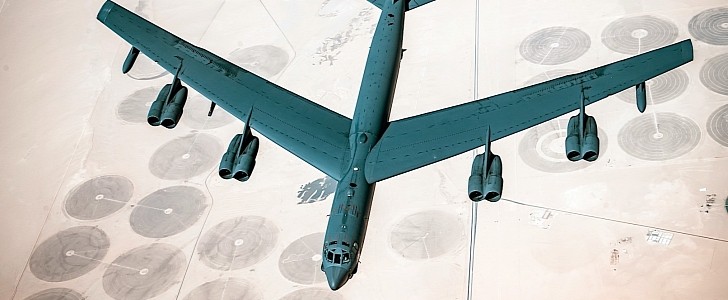There are few words one can use to properly describe the B-52 Stratofortress. It’s probably the nickname phrase some people use that paints it the best: Big Ugly Fat Fella (BUFF). And here, you can see how close to the truth those words are.
The Stratofortress first flew back in 1952, at a time when tensions between East and West were rapidly climbing. It was born in the hangars of Boeing as a strategic bomber, a sub-sonic machine capable of dropping vast quantities of bombs, including nuclear if need be, onto the heads of the enemy.
And it did so many times. One of its most notable contributions was to Operation Desert Storm back in the 1990s, when it dropped 40 percent of all bombs the allies used. It generally releases its deadly cargo from very high up, as it can fly at altitudes of up to 50,000 feet (15,166 meters).
Any lower, and its mammoth size is instantly visible in the clear sky. As clearly shown here, in this pic of one of the B-52 taken back in March of last year and recently published by the U.S. Air Force (USAF) as part of its Year in Photos album.
This particular plane was flying at the time over an undisclosed region in the U.S. Central Command area of responsibility (an area that includes Afghanistan, Egypt, Iran, Iraq, and the United Arab Emirates, among others). The photo was snapped just as the plane, deployed with the 5th Bomb Wing, was moving away after getting its fill from a KC-135 Stratotanker of the 350th Expeditionary Air Refueling Squadron.
Even if it is incredibly old, the Big Ugly Fat Fella will continue to cast its shadow over America’s enemy nations well into the 1950s, becoming the world’s first military aircraft to be in service for over a century.
And it did so many times. One of its most notable contributions was to Operation Desert Storm back in the 1990s, when it dropped 40 percent of all bombs the allies used. It generally releases its deadly cargo from very high up, as it can fly at altitudes of up to 50,000 feet (15,166 meters).
Any lower, and its mammoth size is instantly visible in the clear sky. As clearly shown here, in this pic of one of the B-52 taken back in March of last year and recently published by the U.S. Air Force (USAF) as part of its Year in Photos album.
This particular plane was flying at the time over an undisclosed region in the U.S. Central Command area of responsibility (an area that includes Afghanistan, Egypt, Iran, Iraq, and the United Arab Emirates, among others). The photo was snapped just as the plane, deployed with the 5th Bomb Wing, was moving away after getting its fill from a KC-135 Stratotanker of the 350th Expeditionary Air Refueling Squadron.
Even if it is incredibly old, the Big Ugly Fat Fella will continue to cast its shadow over America’s enemy nations well into the 1950s, becoming the world’s first military aircraft to be in service for over a century.










